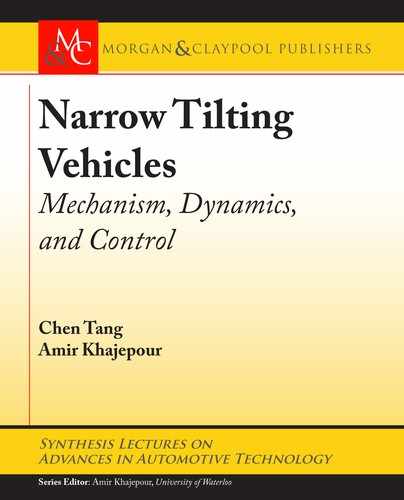
4.5. FEED-FORWARD TILTING CONTROL 41
feedback controller design is presented based on the roll angle envelope from Section 4.3.3. For
best transient performances under harsh maneuvers, the full LTR envelope from Section 4.3.4
is implemented as constraints in an integrated envelope control architecture.
4.5 FEED-FORWARD TILTING CONTROL
Section 4.3 introduces different implementation of the proposed roll envelope control for an
energy-efficient tilting control. To demonstrate how the idea could be adopted in controller
designs, this section begins with the most straight-forward use, a feed-forward controller solely
for active tilting control.
e major benefits of active tiling control using the feed-forwarded approach are con-
sidered as its easy implementation and the proactive control actions. e algorithm is not de-
pendent on roll angle measurements or estimations, and the control action comes proactively
which enhances the vehicle roll stability in a highly efficient manner. e implementation of
the controller is illustrated in Figure 4.5.
A ramp steering maneuver with vehicle travelling at 60 km/h is simulated. Various roll
envelope thresholds LTR
lim
are adopted, the results of which are shown in Figure 4.6. It can be
seen that, for a proper tuned feed-forward controller at low speed, envelope-based active tilting
controller can track specified LTR thresholds as envelope boundaries. e more conservative the
thresholds are, the more tilting control efforts are required, and vehicle starts to tilt at an earlier
stage. e envelope boundary settings can then be used to improves the energy efficiency while
still maintain the vehicle stability to a certain level.
Actuator
Dynamics
Feed-forward
Tilting Control
Driver
Command
Vehicle
δ
u
T
x
Figure 4.5: Envelope-based feed-forward tilting control.
..................Content has been hidden....................
You can't read the all page of ebook, please click here login for view all page.
